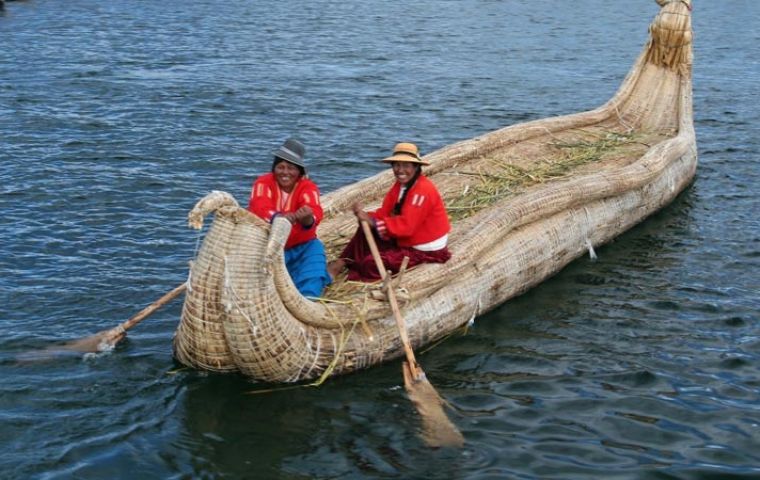MercoPress. South Atlantic News Agency
Lack of rain threatens the world’s highest lake in the world
 The typical canoes of Titicaca made out of floating reed or totora
The typical canoes of Titicaca made out of floating reed or totora The lack of rains in most of Bolivia has caused the level of the highest lake in the world, Titicaca, shared by Bolivia and Peru, to drop 4.5 metres in the last month, according to government reports quoted in La Paz press.
The intense and prolonged drought in the Andean highlands could have serious consequences for fisheries and the wild life in the lake warn local authorities.
According to La Prensa, Hernan Tuco Bolivian deputy head of Civil Defence said that the absence of rainfall and the torrid heat, averaging 18 Celsius in the last two weeks (completely abnormal for this time of the year) are endangering aquatic biodiversity, the main commercial species of the lake and the native flora.
Lake Titicaca is 3.810 metres above sea level between the Peruvian province of Puno and Bolivia’s La Paz province covering an area of 8.562 square kilometres of which 4.772 are under Peruvian jurisdiction and 3.790 in Bolivia’s. The lake is 204 kilometres long and 65 wide. By volume of water it is also the largest lake in South America.
Felix Trujillo from the Bolivian Meteorological and Hydrological Service said that “the situation is coming very close to the historic record of 1943, when the water level went down five metres”.
The opposite happened in 1986 when excess rains from the El Niño phenomenon swelled the lake level a metre over its average.
“A quick descent of the water level will cause misbalance in the flora and fauna of the region, particularly fishing from which many coastal communities depend for subsistence” says a report from the Bi-national Titicaca Authority (Bolivia-Peru).
The Titicaca lake ecosystem not only has different species of fish, birds and the giant frog, but also a wide range of floating and submerged vegetation (particularly the totora or floating reed) which are used for human and animal feeding as well as textiles and the classic canoes used by indigenous communities.




Top Comments
Disclaimer & comment rules-

Read all commentsWelcome back to El Niño. Do not look under your bed for Bush or global warming, but in the historical records of the Pacific currents...
Nov 09th, 2009 - 11:12 am 0Commenting for this story is now closed.
If you have a Facebook account, become a fan and comment on our Facebook Page!